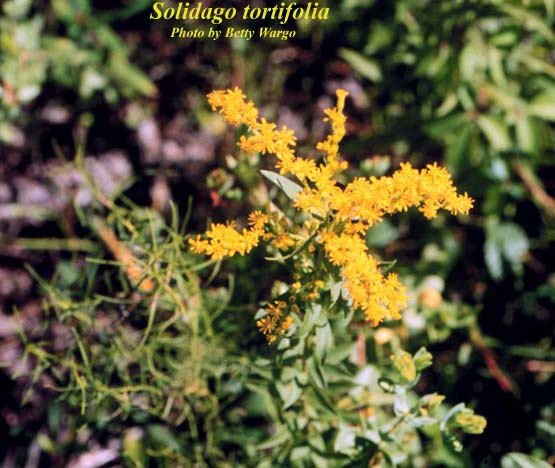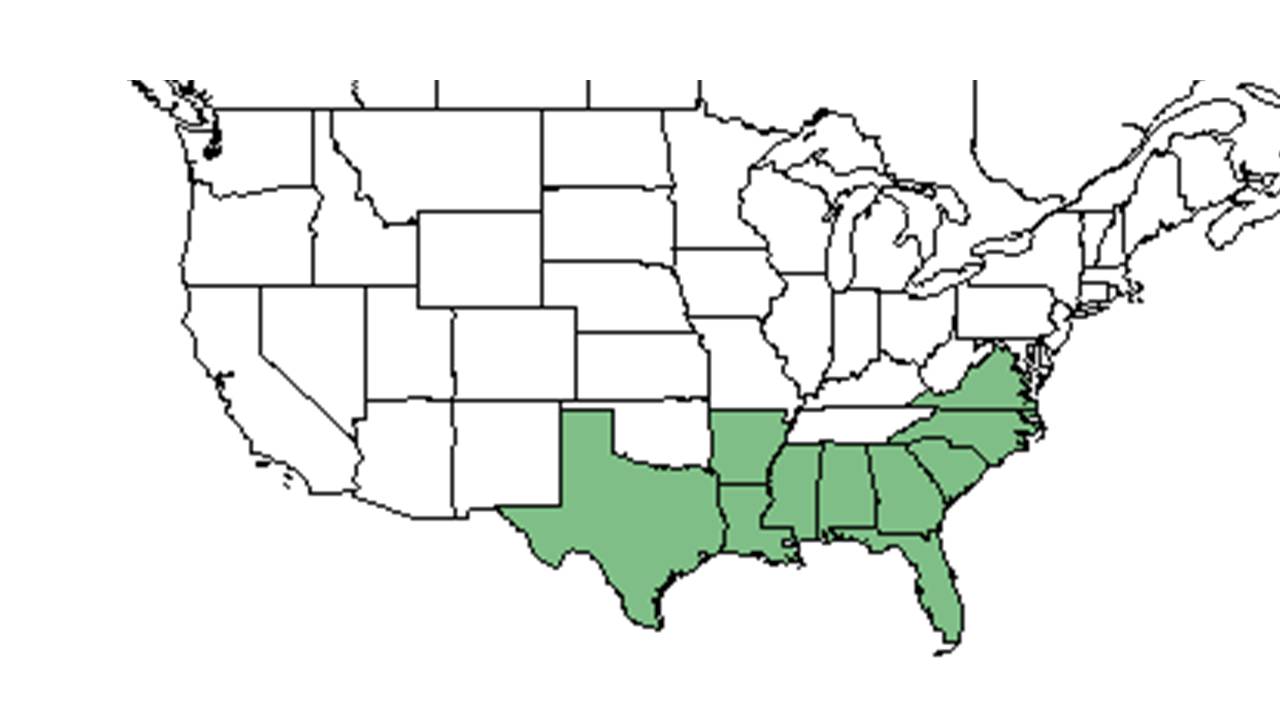Difference between revisions of "Solidago tortifolia"
(→Ecology) |
|||
| Line 27: | Line 27: | ||
==Ecology== | ==Ecology== | ||
===Habitat=== <!--Natural communities, human disturbed habitats, topography, hydrology, soils, light, fire regime requirements for removal of competition, etc.--> | ===Habitat=== <!--Natural communities, human disturbed habitats, topography, hydrology, soils, light, fire regime requirements for removal of competition, etc.--> | ||
| − | In the Coastal Plain in Florida and Georgia, ''S. tortifolia'' has been found in loamy sand around upper boarder of seasonally wet depression in a longleaf pine community; pine flatwoods; bordering slash pine plantations in deep sandy soil; next to sandy ridge; sandy soil bordering a mixed forest; scrub oak sand ridge; pond-pine flatwoods; sand pine scrub; longleaf pine-wiregrass scrub oak ridge; open boggy slope; border of live oak hammock near a river; fallow field on a sandy ridge; longleaf pine-wiregrass flat pineland. <ref name="FSU Herbarium">Florida State University Robert K. Godfrey Herbarium database. URL: [http://herbarium.bio.fsu.edu http://herbarium.bio.fsu.edu]. Last accessed: July 2015. Collectors: Loran C. Anderson, Wilson Baker, Cecil R Slaughter, M Minno, R.K. Godfrey, John Morrill, J. Nelson, R. H. Wnek, Nancy Z. Edmondson, H. S. Conard, Robert L. Lazor, J. M. Kane, Cecil R Slaughter, J.C. Semple, R. Wunderlin, J. Poppleton, Eliane Norman. States and Counties: Florida: Bay, Calhoun, Columbia, Dixie, Flagler, Gulf, Jackson, Jefferson, Leon, Liberty, Madison, Polk, Putnam, Sarasota, Taylor, Union, Volusia, Wakulla, Washington. Georgia: Baker, Thomas. Compiled by Tall Timbers Research Station and Land Conservancy.</ref> In disturbed habitats, it has been found in loamy sand among roadside grasses; wet powerline corridors; sandy loam among rock ledges; sandy clearings; banks of swale between highway and railway; and railroad banks. Associated species include ''Aster concolor, Helianthus radula, Pityopsis graminifolia, Ceanothus microphyllus, Baptisia simplicifolia, Aster linarifolia, Eupatorium rotundifolium, Silphium compositifolium, Angelica dentata, Aster adnatus, Ilex glabra'', and ''Sericocarpus tortifolius.'' <ref name="FSU Herbarium"/> | + | In the Coastal Plain in Florida and Georgia, ''S. tortifolia'' has been found in loamy sand around upper boarder of seasonally wet depression in a longleaf pine community; pine flatwoods; bordering slash pine plantations in deep sandy soil; next to sandy ridge; sandy soil bordering a mixed forest; scrub oak sand ridge; pond-pine flatwoods; sand pine scrub; longleaf pine-wiregrass scrub oak ridge; open boggy slope; border of live oak hammock near a river; fallow field on a sandy ridge; longleaf pine-wiregrass flat pineland.<ref name="FSU Herbarium">Florida State University Robert K. Godfrey Herbarium database. URL: [http://herbarium.bio.fsu.edu http://herbarium.bio.fsu.edu]. Last accessed: July 2015. Collectors: Loran C. Anderson, Wilson Baker, Cecil R Slaughter, M Minno, R.K. Godfrey, John Morrill, J. Nelson, R. H. Wnek, Nancy Z. Edmondson, H. S. Conard, Robert L. Lazor, J. M. Kane, Cecil R Slaughter, J.C. Semple, R. Wunderlin, J. Poppleton, Eliane Norman. States and Counties: Florida: Bay, Calhoun, Columbia, Dixie, Flagler, Gulf, Jackson, Jefferson, Leon, Liberty, Madison, Polk, Putnam, Sarasota, Taylor, Union, Volusia, Wakulla, Washington. Georgia: Baker, Thomas. Compiled by Tall Timbers Research Station and Land Conservancy.</ref> In disturbed habitats, it has been found in loamy sand among roadside grasses; wet powerline corridors; sandy loam among rock ledges; sandy clearings; banks of swale between highway and railway; and railroad banks. Associated species include ''Aster concolor, Helianthus radula, Pityopsis graminifolia, Ceanothus microphyllus, Baptisia simplicifolia, Aster linarifolia, Eupatorium rotundifolium, Silphium compositifolium, Angelica dentata, Aster adnatus, Ilex glabra'', and ''Sericocarpus tortifolius.''<ref name="FSU Herbarium"/> |
===Phenology=== <!--Timing off flowering, fruiting, seed dispersal, and environmental triggers. Cite PanFlora website if appropriate: http://www.gilnelson.com/PanFlora/ --> | ===Phenology=== <!--Timing off flowering, fruiting, seed dispersal, and environmental triggers. Cite PanFlora website if appropriate: http://www.gilnelson.com/PanFlora/ --> | ||
Revision as of 18:36, 13 May 2021
| Solidago tortifolia | |
|---|---|

| |
| Photo by Betty Wargo, Atlas of Florida Vascular Plants | |
| Scientific classification | |
| Kingdom: | Plantae |
| Division: | Magnoliophyta – Flowering plants |
| Class: | Magnoliopsida – Dicotyledons |
| Order: | Asterales |
| Family: | Asteraceae ⁄ Compositae |
| Genus: | Solidago |
| Species: | S. tortifolia |
| Binomial name | |
| Solidago tortifolia Elliott | |

| |
| Natural range of Solidago tortifolia from USDA NRCS Plants Database. | |
Common names: Twistleaf goldenrod, Leafy pineywoods goldenrod
Contents
Taxonomic notes
Description
A description of Solidago tortifolia is provided in The Flora of North America.
Distribution
Ecology
Habitat
In the Coastal Plain in Florida and Georgia, S. tortifolia has been found in loamy sand around upper boarder of seasonally wet depression in a longleaf pine community; pine flatwoods; bordering slash pine plantations in deep sandy soil; next to sandy ridge; sandy soil bordering a mixed forest; scrub oak sand ridge; pond-pine flatwoods; sand pine scrub; longleaf pine-wiregrass scrub oak ridge; open boggy slope; border of live oak hammock near a river; fallow field on a sandy ridge; longleaf pine-wiregrass flat pineland.[1] In disturbed habitats, it has been found in loamy sand among roadside grasses; wet powerline corridors; sandy loam among rock ledges; sandy clearings; banks of swale between highway and railway; and railroad banks. Associated species include Aster concolor, Helianthus radula, Pityopsis graminifolia, Ceanothus microphyllus, Baptisia simplicifolia, Aster linarifolia, Eupatorium rotundifolium, Silphium compositifolium, Angelica dentata, Aster adnatus, Ilex glabra, and Sericocarpus tortifolius.[1]
Phenology
It has been recorded flowering and fruiting January through November. [1]
Seed dispersal
This species is thought to be dispersed by wind. [2]
Conservation and management
Cultivation and restoration
Photo Gallery
References and notes
- ↑ 1.0 1.1 1.2 Florida State University Robert K. Godfrey Herbarium database. URL: http://herbarium.bio.fsu.edu. Last accessed: July 2015. Collectors: Loran C. Anderson, Wilson Baker, Cecil R Slaughter, M Minno, R.K. Godfrey, John Morrill, J. Nelson, R. H. Wnek, Nancy Z. Edmondson, H. S. Conard, Robert L. Lazor, J. M. Kane, Cecil R Slaughter, J.C. Semple, R. Wunderlin, J. Poppleton, Eliane Norman. States and Counties: Florida: Bay, Calhoun, Columbia, Dixie, Flagler, Gulf, Jackson, Jefferson, Leon, Liberty, Madison, Polk, Putnam, Sarasota, Taylor, Union, Volusia, Wakulla, Washington. Georgia: Baker, Thomas. Compiled by Tall Timbers Research Station and Land Conservancy.
- ↑ Kirkman, L. Katherine. Unpublished database of seed dispersal mode of plants found in Coastal Plain longleaf pine-grasslands of the Jones Ecological Research Center, Georgia.